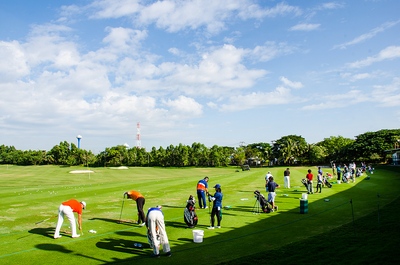 Many golf betting fans choose to place wagers on the tournament winner market. As we cover in detail in our article on the subject, punters can opt to place a ‘to win’ bet that pays out if their chosen player wins the tournament (whether by posting the best score overall or winning a playoff if they post the joint best score).
Many golf betting fans choose to place wagers on the tournament winner market. As we cover in detail in our article on the subject, punters can opt to place a ‘to win’ bet that pays out if their chosen player wins the tournament (whether by posting the best score overall or winning a playoff if they post the joint best score).
Alternatively bettors can place an each way bet that pays out if the player wins, but also pays out at a fraction of the odds – usually a quarter or a fifth – if the player finishes within the top five, six or other specified number of positions (this can vary from bookie to bookie and from tournament to tournament).
There are many alternative betting markets available to golf punters who fancy something a little different from the main tournament winner market though. One of the most popular is to back a specific player for a Top 5 Finish, a Top 10 Finish or a Top 20 Finish.
In this article we’ll explain how these markets work, and which rules and scenarios you should be aware of if you want to place these bets. First though we’ll examine why you might choose to bet on a player to finish in the top 10, for instance, instead of just backing them to win with an each way bet.
Why Bet on Top 5/10/20 in Golf?

The most obvious reason someone would choose to bet on a player finishing in the top five, 10 or 20 positions in a given golf tournament is that they think that player will do well, but perhaps not well enough to actually win the event. In that scenario one might of course opt for an each way bet, which might, for instance, pay out on a player finishing in the top five positions. The difference is that placing an each way bet requires double the stake. This is because an each way bet is effectively two bets: one on the player to win, and one on them to place, so a £10 each way bet will cost the bettor £20.
The other reason is that bookies only pay out on each way bets to five or six places in most tournaments, with occasional bookie offers extending that to more, perhaps as high as 10 for some of the biggest tournaments. As such, backing a player to finish the tournament in the top 10 or especially the top 20 would be something that wouldn’t be covered by an each way bet generally speaking.
When placing a bet on a Top 5/10/20 finish it is just one bet, so a £10 bet on a player to finish in the top five would cost just £10 rather than the £20 a £10 each way bet would cost. There is just one price too, which contrasts with an each way bet on the tournament winner market which pays out at one price if the player wins and a fraction of that price if they place; note that if the player wins the tournament, the bookie pays out on both the “win” and “place” bets.
The key question for golf punters then, is which is better in terms of odds, to place an each way bet on the tournament winner market or to back a player for a Top 5/10/20 Finish?
How Do Odds Compare Between Outright Winner and Top 5/10/20 Finish?
In order to discuss how the odds compared between backing a player to win a tournament outright (whether on the nose or each way) and backing a player to finish in the top 5/10/20, it is best to give a real life example. Here we present the odds from selected players taking part in the 2020 3M Open on the PGA Tour. Note that the odds were correct at the time of writing, which was a day before the tournament started.
| Player | Tournament Winner Odds | Each Way Odds (Top 5 ¼ Odds) | Top 5 Finish Odds | Top 10 Finish Odds | Top 20 Finish Odds |
|---|---|---|---|---|---|
| Dustin Johnson | 11/1 | 11/4 | 5/2 | 6/4 | 4/6 |
| Tony Finau | 14/1 | 7/2 | 3/1 | 6/4 | 8/11 |
| Tommy Fleetwood | 14/1 | 7/2 | 10/3 | 13/8 | 4/5 |
| Brooks Koepka | 14/1 | 7/2 | 3/1 | 6/4 | 8/11 |
| Paul Casey | 22/1 | 11/2 | 5/1 | 9/4 | 11/10 |
| Bubba Watson | 36/1 | 9/1 | 13/2 | 3/1 | 6/4 |
| Doc Redman | 50/1 | 25/2 | 9/1 | 9/2 | 2/1 |
| Charley Hoffman | 80/1 | 20/1 | 14/1 | 7/1 | 10/3 |
| Brandon Grace | 100/1 | 25/1 | 16/1 | 8/1 | 10/3 |
| Scott Piercy | 120/1 | 30/1 | 20/1 | 10/1 | 5/1 |
| Luke Donald | 250/1 | 125/2 | 40/1 | 20/1 | 10/1 |
| Doug Ghim | 500/1 | 125/1 | 80/1 | 33/1 | 16/1 |
| Bo Van Pelt | 1000/1 | 250/1 | 150/1 | 66/1 | 28/1 |
Based on the above data we can see the obvious pattern that the odds will get shorter as you increase the number of places. That is, backing Dustin Johnson to win (so covering just one single place) would give odds of 11/1, which shortens to 5/2 for a Top 5 Finish, 6/4 for a Top 10 Finish and just 4/6 for Top 20 Finish. This is not at all surprising, of course, as the chance that any player will finish in the top 20 is far greater than them finishing in the top five places or of winning the tournament.
The each way terms for this particular tournament vary from bookie to bookie, but the odds above are those quoted from a top bookie whose each way terms were to pay a quarter of the “to win” odds for the top five places. As you can see, in all cases the odds on the each way part of the tournament winner bets are higher than the odds offered on the Top 5 Finish bets. But of course the bettor would have had to place double the stakes for the sometimes only slightly better odds (for example Brooks Koepka).
As such, which option you choose really depends on whether you think your chosen player might actually win the tournament. If not, you might choose to save half your stake and take the slightly worse odds for the player to finish in the top five. Or, of course, you might just opt to back them to finish in the top 10 or 20 to reduce the risk of losing the bet (but also to reduce the return as the odds are lower).
What About Ties and Dead Heats?
 Dead heat rules can cause disappointment among punters who think they’ve won their bet only to find they have not made as much as they thought or, worse still, actually made a loss despite winning their bet! There are no dead heats when it comes to tournament winners because play-offs always result in a winner being declared, except in exceptional circumstances such as when a hurricane causes the abandonment of an event.
Dead heat rules can cause disappointment among punters who think they’ve won their bet only to find they have not made as much as they thought or, worse still, actually made a loss despite winning their bet! There are no dead heats when it comes to tournament winners because play-offs always result in a winner being declared, except in exceptional circumstances such as when a hurricane causes the abandonment of an event.
There are however often ties for the various other places. When you back a player to finish in the top 5, 10 or 20, you are talking about the place in which they finish, rather than the 5th, 10th or 20th best score. As such, it is very possible (and indeed common) for more than five players to finish in the top five, more than 10 to finish in the top 10 and so on.
To explain further, let us take another real life example, this time the result of the US Masters from 2019.
| Player | Position | Score |
|---|---|---|
| Tiger Woods | 1 | 275 |
| Dustin Johnson | T2 | 276 |
| Brooks Koepka | T2 | 276 |
| Xander Schauffele | T2 | 276 |
| Jason Day | T5 | 277 |
| Tony Finau | T5 | 277 |
| Francesco Molinari | T5 | 277 |
| Webb Simpson | T5 | 277 |
| Patrick Cantlay | T9 | 278 |
| Rickie Fowler | T9 | 278 |
| Jon Rahm | T9 | 278 |
| Justin Harding | T12 | 280 |
| Matt Kuchar | T12 | 280 |
| Ian Poulter | T12 | 280 |
| Justin Thomas | T12 | 280 |
| Bubba Watson | T12 | 280 |
| Aaron Wise | 17 | 281 |
| Patton Kizzire | T18 | 282 |
| Phil Mickelson | T18 | 282 |
| Adam Scott | T18 | 282 |
| Lucas Bjerregaard | T21 | 283 |
| Matthew Fitzpatrick | T21 | 283 |
| Si Woo Kim | T21 | 283 |
| Kevin Kisner | T21 | 283 |
| Rory McIlroy | T21 | 283 |
| Thorbjørn Olesen | T21 | 283 |
| Jordan Spieth | T21 | 283 |
| Kyle Stanley | T21 | 283 |
As you can see, there is no disputing the winner (that was Tiger’s 15th major victory by the way), but three players tied for second place, meaning that the next four players (who each scored 277, one shot behind those in second) were not tied for third, but instead tied for fifth as there were four players ahead of them.
If backing a player to finish in the top five, the bookies would pay out at the quoted odds for Tiger Woods, Dustin Johnson, Brooks Koepka and Xander Schauffele, but dead heat rules would come into play for the players who have finished tied for fifth.
This means that if you had backed Webb Simpson to finish in the top five at odds of 8/1 with a stake of £10, you might expect a payout of £90 (including your original stake). Alas, the bookie will instead settle your bet according to dead heat rules. In this instance only one quarter of your bet will have been deemed a winner as effectively Simpson “shared” fifth place with three others.
As such you lose £7.50 of your initial bet and your winning stake is effectively reduced to 25%, so it would be as if you placed a bet of £2.50. Your payout, therefore (including the reduced £2.50 stake you get back) would be just £22.50. Note that the same would apply to an each way bet that paid out to five places.
In the example above, those backing any of the players who tied for ninth to finish in the top 10 would have their stake reduced by a third. If you had backed any of the players who tied for 18th place to finish in the top 20, however, you would be paid out as expected without your stake getting reduced as they are the 18th, 19th and 20th players on the leaderboard.
Dead heat rules are standardised throughout the industry so they will apply at whichever bookie you place your bets, unless there is a special offer on a golf tournament that specifically states that ties will not reduce payouts (which sometimes happens on majors and other big tournaments).
Tips for Top 5/10/20 Finish Betting on Golf
 Essentially these bets are for punters who want to reduce the risk or their stake compared to placing tournament winner each way bets, or tournament winner “on the nose” bets for that matter. Because of the nature of golf tournaments, especially at the top level, the likelihood of ties is fairly high and this should be taken into account when placing most bets on golf.
Essentially these bets are for punters who want to reduce the risk or their stake compared to placing tournament winner each way bets, or tournament winner “on the nose” bets for that matter. Because of the nature of golf tournaments, especially at the top level, the likelihood of ties is fairly high and this should be taken into account when placing most bets on golf.
If you fancy a player will do well at a given tournament but not well enough to win, opting to back them to finish, for instance, in the top 20 would be a good option to increase the chance of winning your bet, while backing them to finish in the top five would cost you half the stake of an each way bet, albeit at slightly worse odds.
When deciding which players to back in these markets, it’s all about doing your research, as with most betting. Finding the players who have performed well at the same course in the past or picking players whose natural game fits the course and conditions is a good place to start.
Another key aspect with a bet like this is looking at the guys who regularly pick up decent cheques. Over the years there have been many players who have been ultra consistent but have struggled to win tournaments. In the modern game players can earn millions of dollars without ever getting over the line – indeed Brian Davis won more than $13m on the US Tour without ever tasting victory!
Players like these often offer great value in the Top 10 or 20 markets due to the long odds typically quoted for them to win. Their chances of winning are indeed slim, but they do have the ability to land these bets whilst still going under the radar.
Ultimately there is always going to be an element of luck involved in golf betting, and the amount of risk you choose to accept will dictate whether you back a player on to win or play it safer and back them to finish in the top five, 10 or 20 places.
